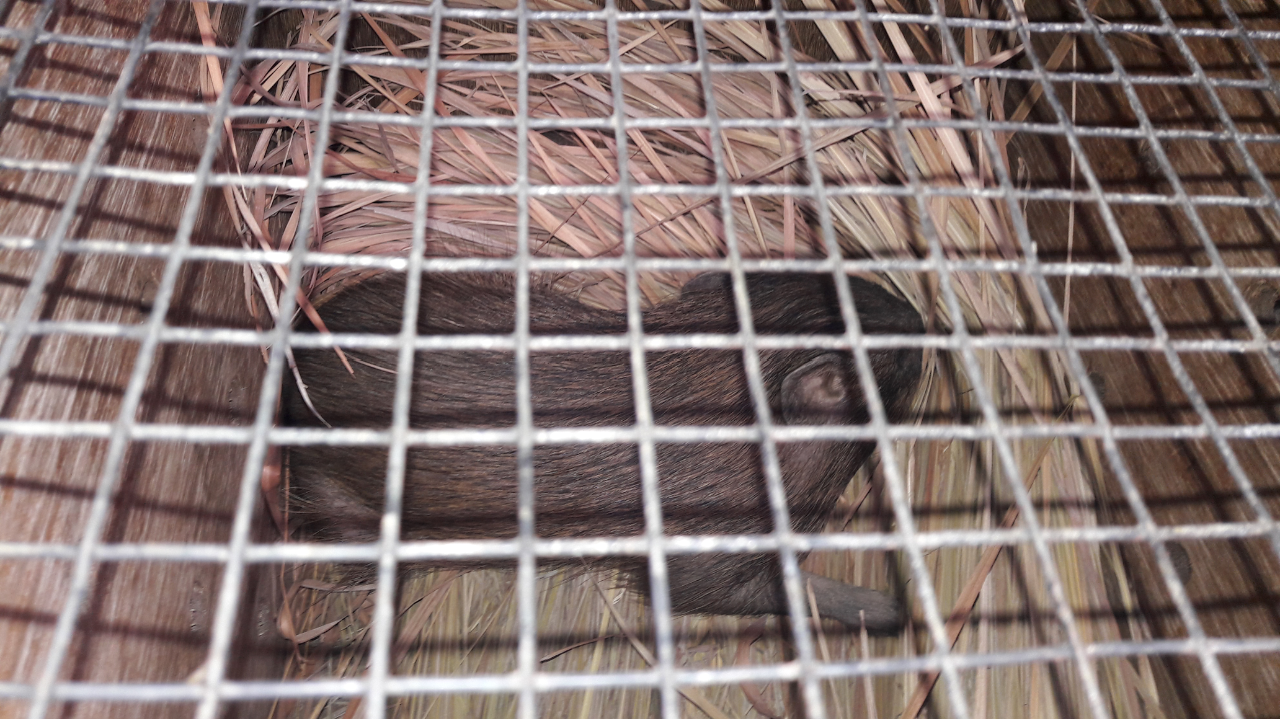Six Pygmy Hogs Released In Bornadi Wildlife Sanctuary Of Udalguri
By Shajid Khan
21 May, 2016
Countercurrents.org

TANGLA,Assam May 21:In an effort for conservation of Pygmy Hog in its natural
habitat six babyPygmy Hogs(2-3 years old) that include 3 male and 3 female were
released inBornadi Wildlife sanctuary of Udalguri district of Assam on Saturday.
The Pygmy Hogswere captive breeded in state capital Guwahati Daniel Craven
and his two colleagues fromDurrell Wildlife Conservation Trust based in Jersey,
were present on the occasion.
BTC Secretary Rabinsan Musahary present on the event said " The release of
the Pigmy Hogs is a great step for the conservation of the species which is
a good news for the nature loving people."
H.K Sarma Director Manas National Park said "Barnadi provides very similar
habitat for Pygmy Hogs as to Manas .It is a timid animal . We have been
successful in breeding it in Manas"
Pygmy Hog is the world’s smallest and rarest extant suid and only a handful
of people can ever claim to have seen it in the wild. It is 55 to 71 cm.
long, weighs around eight to 11 kg. and stands just 12 inches (20 to 30
cm.) tall. The days when the pygmy hog was common along the foothill plains
of the Himalaya in India, Bhutan and Nepal are long past.
By the 1980s, it was already known to be endangered with only two isolated
populations on record – in the Manas in Barpeta and Barnadi Wildlife
Sanctuary in Udalguri of Assam.
The pygmy hog featured in the first IUCN/WWF (1984) list of the 12 most
threatened animal species in the world. The population in Barnadi was
believed to have been lost by 1981, due to extensive habitat burning, until
a small number was rediscovered in 1990. However, no pygmy hog has been
recorded there since 1994. By the mid-90s, the situation was so grim that
it was classified as critically endangered by the International Union for
the Conservation of Nature (IUCN). But this was one species, a small group
of committed wildlife researchers and conservationists were just not ready
to lose.
In 1995, a group of organisations, including the Durrell Wildlife
Conservation Trust based in Jersey, Channel Islands, the IUCN’s Pigs,
Peccaries and Hippos Specialist Group, the Assam Forest Department and the
Indian government, initiated the Pygmy Hog Conservation Programme (PHCP).
PHCP researchers began a seven-year study of the pygmy hog to understand
its conservation issues and suggest solutions to revive its population in
the wild. The study initiated field study surveys to determine the
species’ distribution, search for any other surviving remnant populations
and identify suitable sites for future reintroduction. It also aimed at
establishing a captive-breeding programme as a safeguard against
extinction, as a source for reintroduction and as a beginning to long-term
field studies on the pygmy hog’s behavioural-ecology and habitat management
requirements. Dr. Goutam Narayan, a wildlife scientist who had earlier
worked for the Bombay Natural History Society, knew just how vital this
project and its recommendations were as it presented the last hope for the
pygmy hog. He therefore chose to dedicate his life to the resurrection of
the species.
The pygmy hog is an important indicator species whose rapid disappearance
is intricately linked to the degradation of Assam’s grasslands.
Historically, its preferred habitat has been the tall, dense, riverine
grassland areas where it feeds on roots, tubers and other vegetable matter
and, occasionally, insects, earthworms and other invertebrates. The
modification and destruction of its habitat for agriculture, settlements
including those by illegal immigrant settlers from Bangladesh and Nepal,
overgrazing by cattle, thatch-grass harvesting, uncontrolled seasonal
burning and flood-control and forestry projects, had led to its systematic
eradication.
The PHCP began its captive-breeding programme in 1996. Six animals were
captured from the wild and bred in custom-built enclosures in Basistha in
Assam, in environs as close to their natural habitat as possible. Their
food was buried in the soil so they would learn to search for tubers and
succulents as they would need to in wild grasslands.
Others present on the ocassion were Dr. Parag Jyoti Deka Project manager PHCP
Goutam Narayan Project Director PHCP besides a handful of media persons.
It is to be mentioned that the Durrell Wildlife Conservation Trust based in
Jersey, Channel Islands, the IUCN’s Pigs, Peccaries and Hippos Specialist
Group, the Assam Forest Department and the BTC government initiated the
Pygmy Hog Conservation Programme (PHCP) and preliminary survey regarding
the same was conducted in 2014 as a part of which 6 Pygmy Hogs were
released today. The 6 Pygmy Hogs are equipped with transmitter and there
movements would be tracked.
Shajid Khan is a Journalist from Assam.Currently
pursuing his graduation in English literature .In his stint of
journalistic experience he has contributed numerous political,
socio-political stories for bountiful national,international as well
as Assam based publications. He also pens analytic commentary on
print and web based publications. Email: [email protected]

